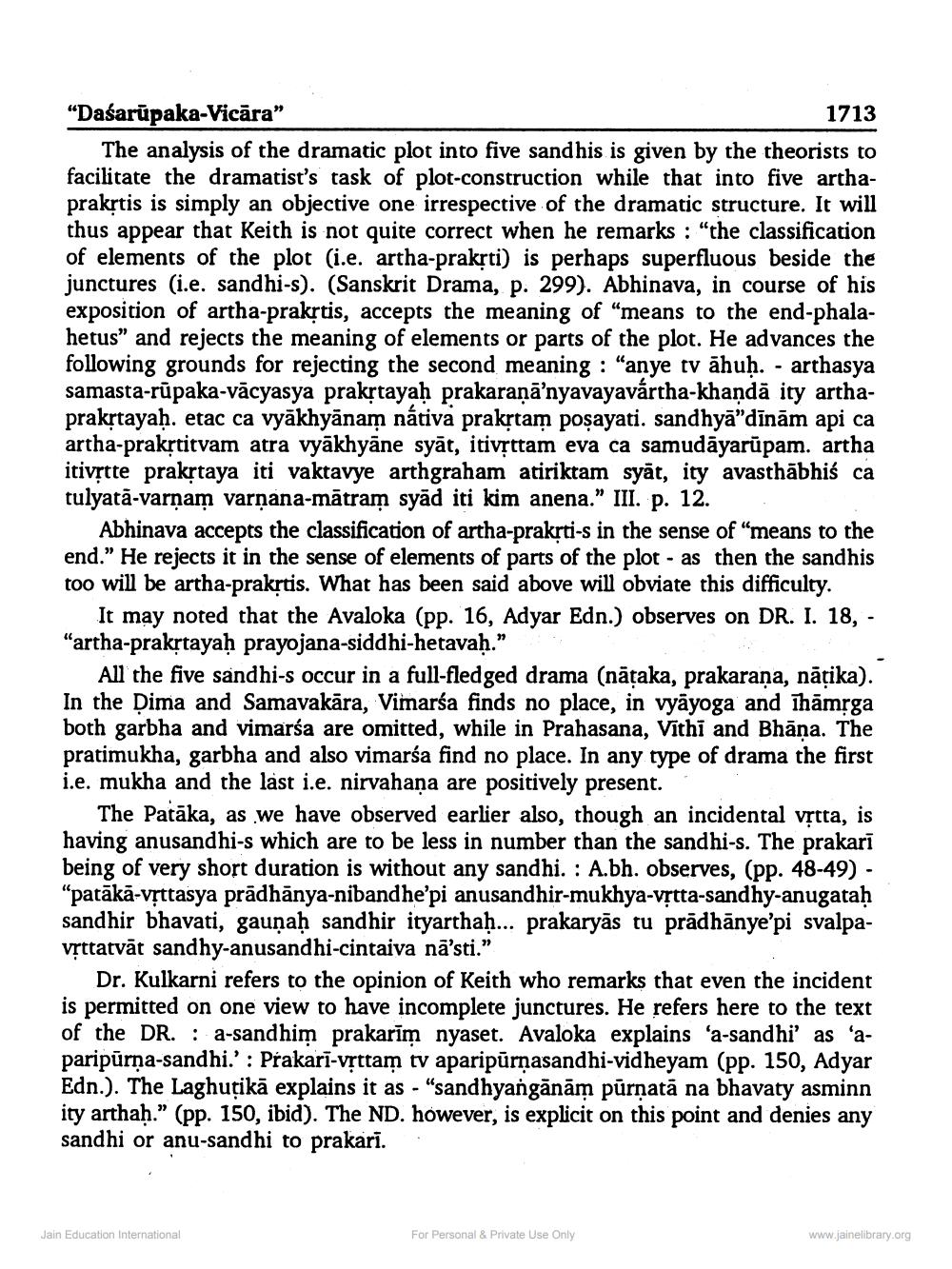________________
"Dasarūpaka-Vicāra"
1713
The analysis of the dramatic plot into five sandhis is given by the theorists to facilitate the dramatist's task of plot-construction while that into five arthaprakstis is simply an objective one irrespective of the dramatic structure. It will thus appear that Keith is not quite correct when he remarks : "the classification of elements of the plot (i.e. artha-prakrti) is perhaps superfluous beside the junctures (i.e. sandhi-s). (Sanskrit Drama, p. 299). Abhinava, in course of his exposition of artha-prakstis, accepts the meaning of “means to the end-phalahetus" and rejects the meaning of elements or parts of the plot. He advances the following grounds for rejecting the second meaning: "anye tv āhuḥ. - arthasya samasta-rūpaka-vācyasya prakstayaḥ prakaraņā'nyavayavártha-khandā ity arthaprakstayaḥ. etac ca vyākhyānam nátiva prakstam poşayati. sandhyā"dīnām api ca artha-prakstitvam atra vyākhyāne syāt, itivȚttam eva ca samudāyarūpam. artha itivștte prakrtaya iti vaktavye arthgraham atiriktam syāt, ity avasthābhis ca tulyatā-varņam varnana-mātram syād iti kim anena.” III. p. 12.
Abhinava accepts the classification of artha-prakrti-s in the sense of "means to the end." He rejects it in the sense of elements of parts of the plot - as then the sandhis too will be artha-prakrtis. What has been said above will obviate this difficulty.
It may noted that the Avaloka (pp. 16, Adyar Edn.) observes on DR. I. 18, - "artha-prakrtayah prayojana-siddhi-hetavah."
All the five sandhi-s occur in a full-fledged drama (nāțaka, prakarana, nātika). In the Dima and Samavakāra, Vimarśa finds no place, in vyāyoga and īhāmrga both garbha and vimarśa are omitted, while in Prahasana, Vithi and Bhāņa. The pratimukha, garbha and also vimarśa find no place. In any type of drama the first i.e. mukha and the last i.e. nirvahana are positively present.
The Patāka, as we have observed earlier also, though an incidental yr having anusandhi-s which are to be less in number than the sandhi-s. The prakari being of very short duration is without any sandhi. : A.bh. observes, (pp. 48-49) - "patākā-vșttasya prādhānya-nibandhe’pi anusandhir-mukhya-vȚtta-sandhy-anugataḥ sandhir bhavati, gauņaḥ sandhir ityarthaḥ... prakaryās tu prādhānye’pi svalpavșttatvāt sandhy-anusandhi-cintaiva nā'sti."
Dr. Kulkarni refers to the opinion of Keith who remarks that even the incident is permitted on one view to have incomplete junctures. He refers here to the text of the DR. : a-sandhim prakarīm nyaset. Avaloka explains 'a-sandhi' as 'aparipurna-sandhi.': Prakarī-vṛttam tv aparipūrņasandhi-vidheyam (pp. 150, Adyar Edn.). The Laghutikā explains it as - "sandhyangānām pūrnata na bhavaty asminn ity arthah.” (pp. 150, ibid). The ND. however, is explicit on this point and denies any sandhi or anu-sandhi to prakari.
Jain Education International
For Personal & Private Use Only
www.jainelibrary.org




